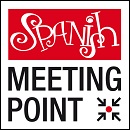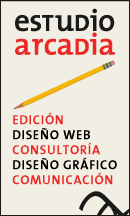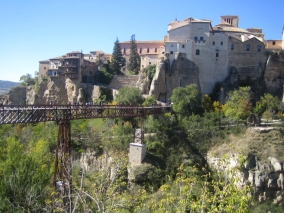Spanish schools and accommodation to study Spanish in Spain
Recent posts
Last schools
introduced
introduced
0 Accommodation

1 Spanish schools

Learning Spanish in Cuenca. The tourist guide to study your Spanish course.
General Information. 56,000 inhabitants. 166 kilometres to the east of Madrid. Cuenca belongs to the Autonomous Community of Castile-La Mancha and is a World Heritage Site, thanks to its old quarter. It is located in the high sierra, whose slopes descend into the deep gorges of the Júcar and Huécar rivers. Cuenca has one of the main sites of the University of Castile-La Mancha with around 4,000 students; the other sites are in Albacete, Ciudad Real and Toledo. Cuenca is a very attractive place to study Spanish with some language schools offering a wide range of courses.
Surrounding Areas. ‘The Enchanted City' (La Ciudad Encantada, 36 kilometres), a landscape of peculiar eroded geological formations, such as the famous Tormo, a rock that defies gravity by becoming much narrower as it reaches its base; the source of the Cuervo River, a beauty spot with organized tourist visits; Belmonte (122 kilometres) and its castle; the town of Beteta (81 kilometres), in the middle of the sierra; Alarcón (83 kilometres), a medieval town and castle, which are protected by a gorge in the Júcar River.
World Heritage Site. Cuenca was declared a World Heritage City in December 1996 thanks to its ensemble of historical buildings.
Main Sights. Plaza de Mangana, where you will find the Mangana Tower (Torre Mangana) and the monument to the Constitution by Gustavo Torner; the Castle, with only a few remains of the Moorish Wall and a gateway arch; St. Nicholas's Square (Plaza de San Nicolás); Plaza Mayor, with the Town Hall building and the Petras Convent (Convento de las Petras); the Chapel of Our Lady of Distress (Ermita de las Angustias) and the Hanging Houses (Casas Colgadas). You can stroll near the gorges of the two rivers, which is a particularly beautiful area in autumn. The monuments are a major attraction for the many students who decide to study Spanish in Cuenca.
Culture. A week of religious music is organized in Holy Week and this has been declared an Event of Cultural Interest; Festival Soundtrack Cuenca (May), which has been held since 2010; the film festival ‘Women in Direction' (Cine de Mujeres), which takes place during a week in November. The following art galleries and museums deserve a special mention: Museo de Arte Abstracto, which is situated next to the Hanging Houses; Fundación Antonio Pérez, which also has abstract pieces and can be found in the old Carmelite Convent; Fundación Torner, another abstract art gallery which is located in St. Paul's Church (Iglesia de los Paules), next to the Parador (a state-run luxury hotel); the Science Museum (Museo de las Ciencias) in the old quarter, which is made up of two buildings, an old convent and its extension building; the Archaeological Museum (Museo Arqueológico de Cuenca); the old St. Paul's Convent (Convento de los Paules), on the other side of St. Paul's Bridge (Puente San Pablo). The Auditorium is situated on the gorge of the Huécar River, with theatre, opera, jazz and ballet programmes. In summer there is an open-air cinema in Plaza de las Carmelitas.
Shopping. You can shop in the city centre, in the area around Calle Carretería. The biggest shopping centre in Cuenca is El Mirador. Typical products and handicrafts can be found in the shops in the old quarter and in a church market in the Iglesia de Santa Cruz. You will also find a fruit and vegetable market in the Plaza de los Carros and a street market or flea market every Tuesday at the Exhibition Site (Recinto Ferial).
Gastronomy. There are many restaurants, bars and beer houses where you can enjoy the Spanish custom of accompanying drinks with tapas. The places that deserve a special mention in Cuenca are La Bodeguilla de Basilio, El Quinto Pecado, and a variety of establishments in Calle San Francisco. Some of the many typical food products from Cuenca are lamb, trout, chorizo sausage, cheeses, ajo arriero (a paste made of garlic, potatoes, egg and olive oil), alhajú, which is a pastry of Arab origin, and the strong local liqueur called Resolí. There is also a typical pâté made from game meats (partridge and hare) called morteruelo. A good place to try this is Casa Eladio. Another restaurant which is well-known for serving specialities of the region and has a menu that combines quality and reasonable prices is El Mesón, which is also known as "el Comunista".
Sports. The many activities on offer include horse riding along special trails, quad biking, microlight flying, descending the water canyons of the Júcar River, climbing and canoeing, as well as other adventure sports. There are a range of schools in Cuenca where you can learn these activities.
Fiestas. Holy Week in Cuenca has been declared an Event of International Tourist Interest. The most famous procession is the Stations of the Cross (Camino del Calvario), whose origins date back to 1916; it is also known as the ‘procession of the drunks' (procesión de las turbas or procesión de los borrachos), representing the mockery and whipping that Jesus Christ received on the road to Calvary. The fiestas of St. Matthew (San Mateo) in the second fortnight of September are the most important in Cuenca; they commemorate the day that Cuenca was conquered by Alfonso VIII of Castile. Young bulls are set loose in the old quarter and there is a varied programme of activities and concerts. Another fiesta that should be highlighted is St. Julian in the second fortnight of August, somewhat less important than San Mateo but with concerts, popular contests, sports tournaments and a fairground...
Transport. Cuenca is connected by AVE, the Spanish high speed train, to Madrid and Valencia. It will also soon be linked to Alicante and Murcia. It is easy to get from Cuenca to other Spanish cities by car or by using the various coach services.
Nightlife. Students who decide to study Spanish in Cuenca will discover a very active nightlife. The partying starts on Thursdays when the university students go out to celebrate the weekend. Most of the pubs, bars and tapas bars can be found in the city centre, around the Cathedral, Plaza Mayor and Calle de San Francisco. It is also worth mentioning two cafés which are good for a quiet evening out: Café Central and Café Hispano.
Surrounding Areas. ‘The Enchanted City' (La Ciudad Encantada, 36 kilometres), a landscape of peculiar eroded geological formations, such as the famous Tormo, a rock that defies gravity by becoming much narrower as it reaches its base; the source of the Cuervo River, a beauty spot with organized tourist visits; Belmonte (122 kilometres) and its castle; the town of Beteta (81 kilometres), in the middle of the sierra; Alarcón (83 kilometres), a medieval town and castle, which are protected by a gorge in the Júcar River.
World Heritage Site. Cuenca was declared a World Heritage City in December 1996 thanks to its ensemble of historical buildings.
Main Sights. Plaza de Mangana, where you will find the Mangana Tower (Torre Mangana) and the monument to the Constitution by Gustavo Torner; the Castle, with only a few remains of the Moorish Wall and a gateway arch; St. Nicholas's Square (Plaza de San Nicolás); Plaza Mayor, with the Town Hall building and the Petras Convent (Convento de las Petras); the Chapel of Our Lady of Distress (Ermita de las Angustias) and the Hanging Houses (Casas Colgadas). You can stroll near the gorges of the two rivers, which is a particularly beautiful area in autumn. The monuments are a major attraction for the many students who decide to study Spanish in Cuenca.
Culture. A week of religious music is organized in Holy Week and this has been declared an Event of Cultural Interest; Festival Soundtrack Cuenca (May), which has been held since 2010; the film festival ‘Women in Direction' (Cine de Mujeres), which takes place during a week in November. The following art galleries and museums deserve a special mention: Museo de Arte Abstracto, which is situated next to the Hanging Houses; Fundación Antonio Pérez, which also has abstract pieces and can be found in the old Carmelite Convent; Fundación Torner, another abstract art gallery which is located in St. Paul's Church (Iglesia de los Paules), next to the Parador (a state-run luxury hotel); the Science Museum (Museo de las Ciencias) in the old quarter, which is made up of two buildings, an old convent and its extension building; the Archaeological Museum (Museo Arqueológico de Cuenca); the old St. Paul's Convent (Convento de los Paules), on the other side of St. Paul's Bridge (Puente San Pablo). The Auditorium is situated on the gorge of the Huécar River, with theatre, opera, jazz and ballet programmes. In summer there is an open-air cinema in Plaza de las Carmelitas.
Shopping. You can shop in the city centre, in the area around Calle Carretería. The biggest shopping centre in Cuenca is El Mirador. Typical products and handicrafts can be found in the shops in the old quarter and in a church market in the Iglesia de Santa Cruz. You will also find a fruit and vegetable market in the Plaza de los Carros and a street market or flea market every Tuesday at the Exhibition Site (Recinto Ferial).
Gastronomy. There are many restaurants, bars and beer houses where you can enjoy the Spanish custom of accompanying drinks with tapas. The places that deserve a special mention in Cuenca are La Bodeguilla de Basilio, El Quinto Pecado, and a variety of establishments in Calle San Francisco. Some of the many typical food products from Cuenca are lamb, trout, chorizo sausage, cheeses, ajo arriero (a paste made of garlic, potatoes, egg and olive oil), alhajú, which is a pastry of Arab origin, and the strong local liqueur called Resolí. There is also a typical pâté made from game meats (partridge and hare) called morteruelo. A good place to try this is Casa Eladio. Another restaurant which is well-known for serving specialities of the region and has a menu that combines quality and reasonable prices is El Mesón, which is also known as "el Comunista".
Sports. The many activities on offer include horse riding along special trails, quad biking, microlight flying, descending the water canyons of the Júcar River, climbing and canoeing, as well as other adventure sports. There are a range of schools in Cuenca where you can learn these activities.
Fiestas. Holy Week in Cuenca has been declared an Event of International Tourist Interest. The most famous procession is the Stations of the Cross (Camino del Calvario), whose origins date back to 1916; it is also known as the ‘procession of the drunks' (procesión de las turbas or procesión de los borrachos), representing the mockery and whipping that Jesus Christ received on the road to Calvary. The fiestas of St. Matthew (San Mateo) in the second fortnight of September are the most important in Cuenca; they commemorate the day that Cuenca was conquered by Alfonso VIII of Castile. Young bulls are set loose in the old quarter and there is a varied programme of activities and concerts. Another fiesta that should be highlighted is St. Julian in the second fortnight of August, somewhat less important than San Mateo but with concerts, popular contests, sports tournaments and a fairground...
Transport. Cuenca is connected by AVE, the Spanish high speed train, to Madrid and Valencia. It will also soon be linked to Alicante and Murcia. It is easy to get from Cuenca to other Spanish cities by car or by using the various coach services.
Nightlife. Students who decide to study Spanish in Cuenca will discover a very active nightlife. The partying starts on Thursdays when the university students go out to celebrate the weekend. Most of the pubs, bars and tapas bars can be found in the city centre, around the Cathedral, Plaza Mayor and Calle de San Francisco. It is also worth mentioning two cafés which are good for a quiet evening out: Café Central and Café Hispano.
© TEXT: SPANISH IN TOUR.
VIDEO: Turismo de Cuenca
VIDEO: Turismo de Cuenca
























